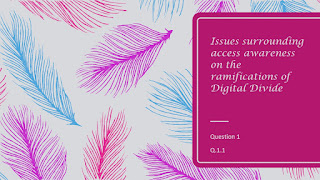Q.2.1
Information fluency skills to analyze the groundbreaking archeological findings
(Homo Naledi) by Professor Lee Berger from Wits University.
Information Fluency
Information
fluency can be described as skills needed not only to search, gather information and
evaluate, but to create useful knowledge that will help to
solve problems. The five (5) Information Fluency process are: Ask,
Acquire, Analyze, Apply and Assess. The information fluency process may
be used to analyze this groundbreaking archeological as follows;
Step
1: Ask
Relevant
questions must be asked in order to receive relevant information. One you
should ask about it is what does species fossils belongs to and how this new
information could contribute to knowledge already acquired that relates to this
species; relevant questions must be asked about the fossil.
Step
2: Acquire
Information
is acquired by scientists leading the expectations. This is done by studying
the fossil in a professional manner in order to acquire information such as how
old the fossil is.
Step
3: Analyze
One
must analyze the information which has been acquired in order to organize and
arrange it. One must make the decision whether the information
acquired about the fossil is trustworthy and if it can be used to make
assumptions about the theory of evaluation.
Step
4: Apply
One
must apply
the information acquired. If the information can be used by scientists
to further their studies in their human species.
Step
5: Assess
One
must assess whether the process of analyzing the groundbreaking archeological
findings could have been carried out effectively, for example by using more
advanced technology to study the remains.
Facts about the
Homo Naledi sapiens:
Ø Homo Naledi
has a small brain case.
Ø
The ribcage and shoulders and pelvis are also
similar to the earlier Homo sapiens.
Ø
Homo Naledi looks more primitive and the teeth
are more similar to apes.
Ø
The legs and feet of naledi indicate that the
fossil was tall.
Ø The
measurements of the Homo Naledi sapiens brain were 1.5 meters tall 45 kilograms.
Additional Information
v
According to Lee,
B. 2015 stated that scientists and researchers, led by Wits University Professor
Lee Berger, believe they've unearthed a new species of human relative in the
world’s richest hominid fossil site, the Cradle of Humankind.
v Homo Naledi is a
previously-unknown species of extinct hominid discovered within the Di-Naledi
Chamber of the Rising Star cave system, Cradle of Humankind, South Africa by
Professor Lee Berger.
v This species is
characterized by body mass and stature similar to small-bodied human
populations but a small Endocrinal volume similar to Australopithecus.
v The while primitive
dentition is generally small and simple in occlusion morphology.
v Homo Naledi exhibits
a human like foot and lower limb, and these human like aspects are contrasted
in the postprandial with a more primitive or Australopithecus-like trunk,
shoulder, pelvis and proximal femur.
481 Words



















